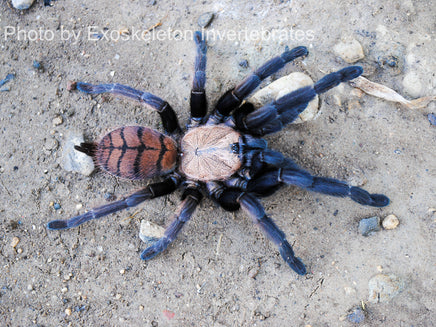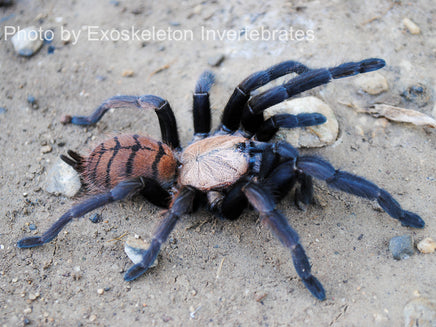Introduction:
Delve into the intriguing world of the Chilobrachys fimbriatus, commonly known as the Indian Violet Tarantula. This captivating species originates from the diverse landscapes of India, where it thrives in the subtropical environments. The Indian Violet is renowned for its striking coloration, featuring shades of earthy browns and vibrant violets, especially noticeable when freshly molted. Ideal for those who appreciate the beauty and complexity of tarantulas, the Chilobrachys fimbriatus is a remarkable specimen that adds an exotic touch to any collection.
Care Details:
- Temperature: The ideal temperature range for the Indian Violet is 75 to 85°F (24 to 29°C), encouraging active behavior and healthy growth.
- Humidity: A humidity level of 70-80% is suitable for this species. Although I don’t use water dishes in my enclosures, they can be added if preferred.
- Housing: As a terrestrial and burrowing species, juveniles are best housed in a 1 oz to 4 oz deli container with fine ventilation. Remember, free containers are available at checkout upon request. Adults require a more spacious enclosure, typically 2 to 3 times their leg span, with ample substrate for burrowing.
Diet:
The Chilobrachys fimbriatus enjoys a diet comprising various insects, such as crickets and different cockroach species. Young spiders should be fed smaller prey, adapting to larger items as they grow. Crush larger prey before feeding if necessary. Regular removal of uneaten food is essential to prevent mold. Occasional small pinky mice can be offered as treats, but in moderation, to avoid nutritional imbalances.
In-depth Facts:
- Latin Name: Chilobrachys fimbriatus
- Common Name: Indian Violet Tarantula
- Locale: Native to India.
- Category: Terrestrial, known for its impressive burrowing skills.
- Size: Females typically reach 6-7 inches, while males mature out around 5 inches.
- Urticating Hairs: Not present in this species.
- Growth Rate: Moderate, allowing for a steady observation of its development.
- Life Span: Females around 12 years, males mature out at around 3 years.
- Recommended Levels: Lovers of asian species.
Stay Connected:
- Instagram: Follow my Instagram for updates and insights.
- YouTube: Visit my YouTube channel for care guides and educational content.
- Facebook: Check out reviews and stories on my Facebook page.
- TikTok: Explore more on my TikTok for engaging content.
Safety Disclaimer:
Handling the Chilobrachys fimbriatus, as with all tarantulas, should be done with care and respect. While not known for being aggressive, they can be quick and may display defensive behavior. Their bites are not considered dangerous to humans but can cause discomfort. Safe and respectful handling is key to a positive experience with these fascinating creatures. Please remember, any handling is at your own risk, and I cannot be held responsible for bites.



